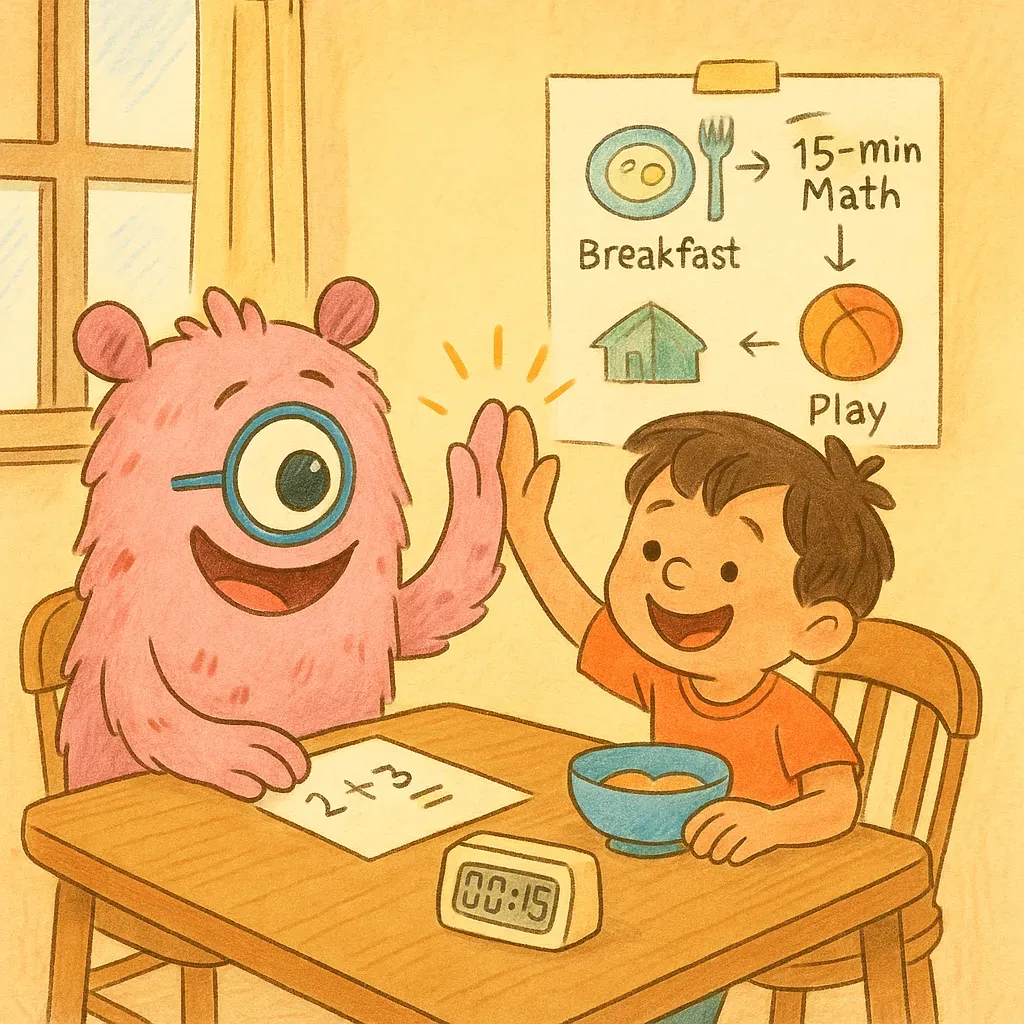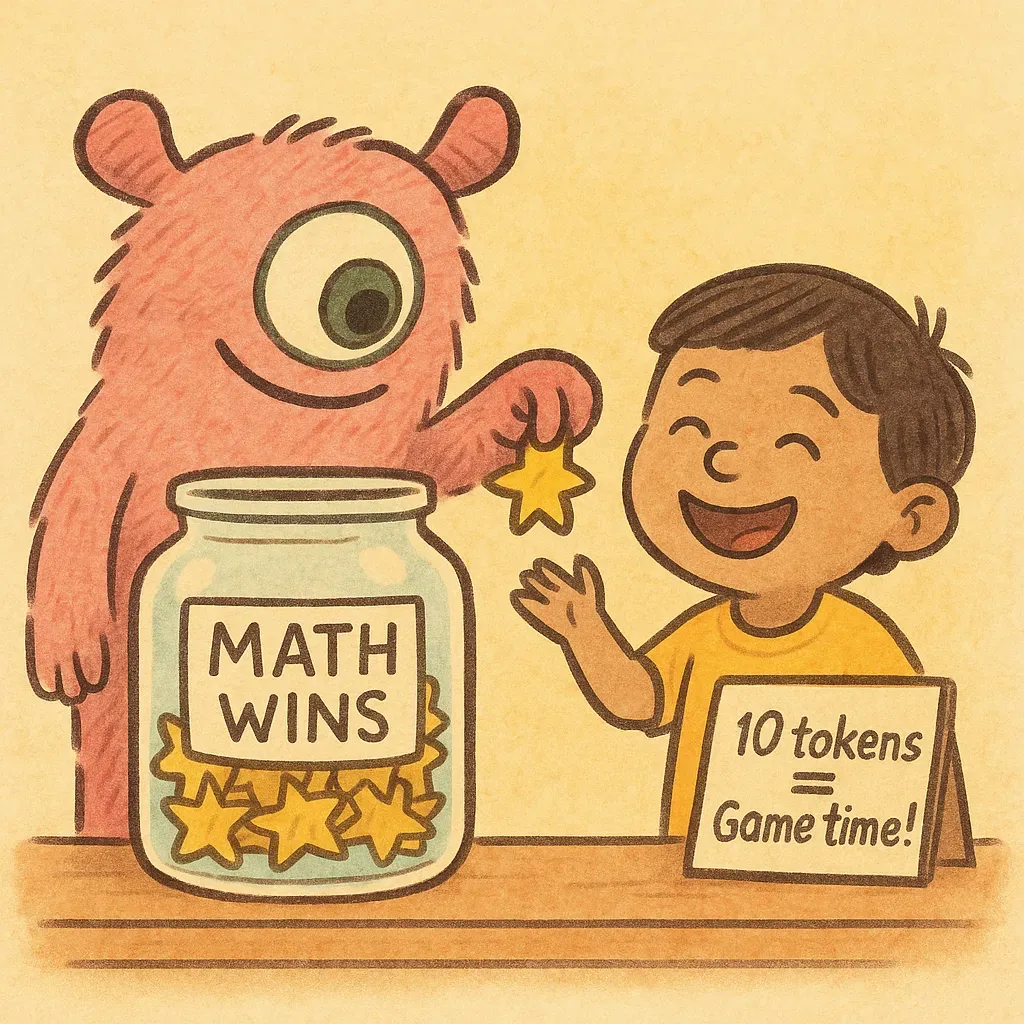How to Create a Daily Math Routine That Works for ADHD Brains
TL;DR: Mathematics can be a particularly challenging subject for students with Attention-Deficit/Hyperactivity Disorder (ADHD). Research shows a strong link between ADHD and math difficulties – for instance, children with low math performance are nearly four times more likely to exhibit ADHD symptoms than their peers. Kids with ADHD often struggle with working memory and sustained attention, which are crucial for problem-solving and computation. This doesn’t mean they can’t excel in math; rather, it means they need a different approach. By establishing a structured, engaging daily math routine tailored to an ADHD brain, parents and educators can help these learners build skills and confidence. In this article, we’ll explore why routine matters for ADHD and outline effective strategies – backed by research – to make daily math practice ADHD-friendly.
ADHD Brains and Math Challenges
ADHD is characterized by difficulties with attention, impulse control, and often hyperactivity. These core symptoms can directly affect academic tasks like math. Children with ADHD commonly have deficits in working memory, which makes it harder to hold multiple steps of a calculation in mind. They might lose track in the middle of a long equation or forget what the problem was asking. In fact, the above study found that ADHD-related working-memory weaknesses explained a significant portion of children’s math struggles. Executive-function skills – such as planning, sequencing, and inhibiting distractions – are often lower in ADHD, which can make multi-step math problems or word problems daunting. Researchers have observed that kids with ADHD may struggle to carry out math solution algorithms, filter out irrelevant information, or remember intermediate results while solving problems. It’s also not uncommon for ADHD and math learning disabilities (like dyscalculia) to co-occur; one large study reported children with ADHD symptoms had more than double the risk of math difficulties compared to those without ADHD. All of these challenges underscore the need for extra support. The good news is that an appropriate routine and teaching approach can help turn these vulnerabilities into areas of growth.
Why Routine Matters for the ADHD Brain
Unstructured time and unpredictable schedules can be tough for children with ADHD to manage. Inconsistent routines may lead to missed homework, last-minute stress, and family conflict. Establishing a daily routine provides external structure that ADHD brains often thrive on. In a qualitative study, parents of kids with ADHD reported significant difficulties managing day-to-day schedules – from homework to bedtimes – and emphasized the importance of an organized, well-defined routine for their child’s success. Other research has consistently found that children with ADHD respond particularly well to the regularity and predictability of daily routines. A reliable routine reduces the need for the child to self-organize (an area of weakness) and creates helpful habits over time. It also lowers anxiety – the child knows what comes next, rather than feeling overwhelmed by a seemingly chaotic day. In short, making math practice a consistent part of the daily rhythm can set ADHD learners up for calmer, more focused study sessions.

Another benefit of routine is that it allows for incremental progress. Rather than cramming a week’s worth of math practice into one sitting (which is likely to exhaust an ADHD child’s attention), a daily routine spreads learning into manageable chunks. Even a brief 15-minute math session every day can build skills more effectively – and with less frustration – than a marathon session once a week. Consistency is key: small daily wins help ADHD students gain confidence and stay engaged. (For more on establishing effective daily rhythms, see our guide on creating a daily routine that works for ADHD brains.)
Designing an ADHD-Friendly Daily Math Routine
What does a successful daily math routine for an ADHD brain look like? It needs to be structured yet flexible, rigorous yet fun. Here are several research-backed strategies to consider when building your routine:
- Keep Sessions Short and Focused: Instead of long, draining homework sessions, aim for short bursts of math practice (e.g. 10–20 minutes) at a consistent time each day. Children with ADHD have limited sustained attention spans, so a brief, focused session is more productive than an hour of struggling. Frequent short sessions also align with how ADHD brains work best – they reduce cognitive overload and leverage the fact that focus can be sharper in short intervals. Set a timer to create a clear endpoint, which can help the child stay on task knowing a break is coming.
- Use Visual Schedules and Checklists: Make the routine predictable by visualizing it. A simple chart or visual schedule can outline the steps of the math session (for example: 5 minutes of flash cards, 10 minutes of problem solving, then a reward). Research shows that using visual activity schedules significantly increases on-task behavior and reduces problem behaviors in children with ADHD. The child can refer to the schedule to know “what’s next,” which provides structure and a sense of accomplishment as they check off each item.
- Start with Movement or Brain Breaks: It may sound counter-intuitive, but integrating physical activity into the routine can improve focus. For instance, begin the math session with a quick movement break – do 5 jumping jacks or a silly dance – or use a kinesthetic learning activity (like hopping along a number line drawn on the floor). Physical exercise has been shown to boost attention and executive function in children with ADHD. A short burst of “brain exercise” before or during math time can help an antsy child reset and channel their energy into the task.
- Incorporate Multi-Sensory Learning: Traditional sit-and-write math drills may not hold the attention of an ADHD learner. Try to engage multiple senses to make math more immersive. For example, use colorful manipulatives (like blocks, beads, or Lego pieces) to represent math problems so the child can touch and see the concepts. Draw out word problems as cartoons together, or practice math facts by clapping, singing, or using apps with auditory feedback.
- Provide Immediate Feedback and Positive Rewards: Motivation can be a huge hurdle in math, especially if the child has faced repeated frustration. ADHD brains are known to crave immediate rewards and feedback due to differences in dopamine regulation. Use this to your advantage by making sure the child gets quick, positive feedback during the routine. Check their work together and celebrate even small successes.
- Leverage Interests to Spark Engagement: One way to combat the “boring” reputation of math is to integrate your child’s personal interests. ADHD kids often can focus intensely when the material is interesting to them. So, if your child loves dinosaurs, make the word problems about T-Rexes and Triceratops. If they’re into Minecraft, use blocks or pickaxe icons in the math problems.
- Be Flexible and Adaptive: While consistency is crucial, an ADHD-friendly routine also allows some flexibility for the unexpected. Some days will be harder – the child might be extra restless or moody. If a particular strategy isn’t working on a given day, don’t force it to the point of meltdown. You can shorten the session, try a different activity, or postpone to a later time when they’re calmer.
For families who find it tough to keep daily routines on track, enrolling children in online math lessons can ensure consistent 1:1 support, helping them stay accountable while learning in a structured yet flexible way.
Conclusion
Creating a daily math routine that works for ADHD brains is all about combining structure with strategy. By understanding the unique challenges ADHD students face – from working-memory deficits to fluctuating attention – we can tailor math practice to fit the way they learn best. A predictable routine provides the scaffold they need to stay on track, while multi-sensory and engaging techniques keep their interest alive. With consistency, patience, and the research-backed tips outlined above, math time can transform from a daily struggle into a more manageable (and even enjoyable) part of your child’s day. Over time, you may find not only improvements in math skills, but also growth in your child’s confidence and independence. ADHD brains might work differently, but with the right routine in place, they are capable of brilliant problem-solving and mathematical thinking. Empower your child with structure, support, and a dash of creativity – and watch them thrive. For further reading on learning differences, you might explore our article on ADHD & Dyscalculia to better understand how ADHD overlaps with math-specific learning challenges.
FAQs:
1. What is the best time of day to schedule math practice for a child with ADHD?
There’s no one-size-fits-all answer, but many families find after a brief movement break - yet before dinner or screen-time - works well. Research shows physical activity can boost post-exercise attention in children with ADHD7, so try 15 minutes of active play followed by your math session.
2. How long should each daily math session be?
Keep it short and focused - about 10–20 minutes. Studies on sustained attention in ADHD suggest productivity drops sharply beyond this window. Frequent, bite-sized sessions beat marathon study blocks for retention and mood.
3. What kinds of rewards keep ADHD learners motivated?
Immediate, tangible rewards work best because ADHD brains are wired to favor near-term reinforcement. Stickers, points toward screen time, or choosing the next math game are all quick motivators. Pair rewards with genuine verbal praise to reinforce effort, not just accuracy.

4. How do I handle frustration or meltdowns during math practice?
First, pause and offer a sensory or movement break. Then scale back to a task the child can succeed at—this restores confidence. Building a “frustration scale” together (1 = calm, 5 = overwhelmed) can help your child signal when they need a reset.
5. Can digital tools or math apps help maintain engagement?
Absolutely—interactive apps provide instant feedback, visual cues, and gamified rewards. Look for apps that allow short levels, progress tracking, and multisensory input (visual plus auditory). If your child prefers physical manipulatives, balance screen time with hands-on activities.
6. Should I include timed drills, or do they add pressure?
Timed drills can be helpful if framed as a personal challenge rather than a test. Use short timers (e.g., 30 seconds) and celebrate improvement over absolute speed. If anxiety spikes, drop the timer and focus on accuracy first.
7. How can I align the school’s math curriculum with our home routine?
Request the weekly lesson plan from your child’s teacher and preview upcoming concepts in bite-sized practice at home. This “front-loading” approach reduces cognitive load when the topic appears in class, boosting confidence and participation.
8. What if my child also has dyscalculia—does the routine change?
Many strategies overlap (short, multisensory practice, visual supports), but progress may be slower and require more concrete manipulatives. See our article on ADHD & Dyscalculia for additional adaptations.
References
- Czamara, D. et al. (2013). Children with ADHD Symptoms Have a Higher Risk for Reading, Spelling and Math Difficulties. PLOS ONE, 8(5): e63859. Link
- Gaye, F. et al. (2024). Working memory and math skills in children with and without ADHD. Neuropsychology, 38(1): 1–16. Link
- Herzog, M. & Casale, G. (2024). Inattention negatively moderates the effectiveness of a mathematics intervention in low performing students. Frontiers in Education, 9: 1276741. Link
- Shikerkar, D. & Vajaratkar, P. (2022). Understanding Daily Routine and Schedule of Children with ADHD – A Qualitative Study. Indian Journal of Occupational Therapy, 54(3): 96-101. Link
- Landry, D. (2010). The Role of Daily Routines in Adolescents Diagnosed with ADHD. PhD Dissertation, Louisiana State University. Link
- Johansen, E. B. et al. (2009). Origins of altered reinforcement effects in ADHD. Behavioral and Brain Functions, 5(7): 7. Link
- Li, D. et al. (2023). Effect of physical activity on attention in school-age children with ADHD: A systematic review and meta-analysis. Frontiers in Physiology, 14: 1189443. Link
- Thomas, N. & Karuppali, S. (2022). The efficacy of visual activity schedule intervention in reducing problem behaviors in children with ADHD: A systematic review. J. Korean Acad. Child Adolesc. Psychiatry, 33(1): 2-15. Link


Comments
Your comment has been submitted successfully!